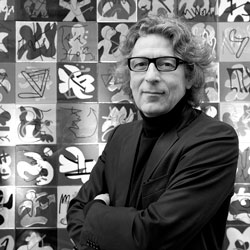2017 Karachi Biennale Artists
Jocelyn Lee
Born in 1962 in Naples (Italy)
Lives and works between New York and Maine (USA)
Jocelyn Lee received her BA in philosophy and visual arts from Yale University, and her MFA in photography from Hunter College. In 2013 she received a NYFA Fellowship, and in 2001 she received a Guggenheim Fellowship. Jocelyn Lee’s first monograph Nowhere But Here was published by Steidl Publishers in December 2010 with a forward by Sharon Olds. In 1996 her work The Youngest Parents was published by DoubleTake Books and The Center for Documentary Studies at Duke University in collaboration with Robert Coles and John Moses. Her works are in the collections of Maison Européenne de la Photographie, Paris, France; The Museum Folkwang, Essen, Germany; The Yale Museum of Art, New Haven, CT; The List Center at MIT, Cambridge, MA; The Portland Museum of Art; Portland, ME; The Nelson Atkins Museum, Kansas City, MO; The Colby College Museum of Art, Waterville, ME; The Haggerty Museum of Art, Milwaukee, WI; The Bowdoin College Museum of Art, Brunswick, ME; The Center for Documentary Studies at Duke University, NC; The Museum of Fine Arts, Houston, TX; The Bates College Museum of Art. Lewiston, ME; and The Farnsworth Art Museum, Rockport, ME; as well as numerous private collections. She is represented by Pace MacGill Gallery in New York and Flatlands Gallery in Amsterdam, The Netherlands. Lee taught photography at Princeton University from 2003-2012 and at The Maine College of Art from 1993-2001. She has been a visiting artist at Yale University, Bowdoin College, Mass College of Art, and New York University.
Jocelyn Lee has submitted photographs from her series Last Light for KB17. The artist writes: “I’ve always used photography as a way to forcibly slow the events of my life. While my mother was dying of lung cancer, I compulsively made thousands of images with three kinds of cameras at every possible increment of time, from split-second to hour-long exposures. As long as my mother was still breathing, I felt the world urgently required my record. Using a medium-format camera, I photographed my mother, her home, our family and friends. With a primitive box camera, I made color pinhole photographs of the landscape around us: my mother’s garden, the view from her hospital room, the fields and yards of neighbors. In the low-light environment of the hospital, I used a digital camera. Together, these images are a meditation on love, the beauty of the physical world, and the transience of both. As my mother struggled to breathe, I made long exposures of the last foxglove, dogwood and delphinium to bloom during her life. I watched the heavy-headed peonies outside her bedroom window flower, ignorant of her pain, and then drop, petal by petal, day by day, to the ground. I took a pinhole photograph of white phlox blowing in the wind during the final hour of her life.”

Last Light, 2008.
(25 images made in the last month of your life with 3 kinds of cameras and exposures ranging from split seconds to 1 hour)
Archival pigment prints
Edition of 5 with 1 AP
Courtesy the artist
Kanwal Tariq
Born in 1990 in Faislabad (Pakistan)
Lives and works in Lahore (Pakistan)
Kanwal Tariq received her Bachelor’s degree in Fine Arts (Painting) from the Institute of Art and Design, GCUF, Faisalabad in 2013 and her Master’s degree in Visual Arts from the National College of Arts, Lahore in 2016. She has exhibited her work in numerous group shows nationally and represented Pakistan at the Caravanserai Regional Festival in Kabul, Afghanistan in March 2017. She currently works at the Zahoor ul Akhlaq Gallery, National College of Arts, Lahore.
Kanwal Tariq writes of her performance for KB17: “This work is a dialogue between being and nothingness, movement and stillness, rawness and realness, reality and fiction.”
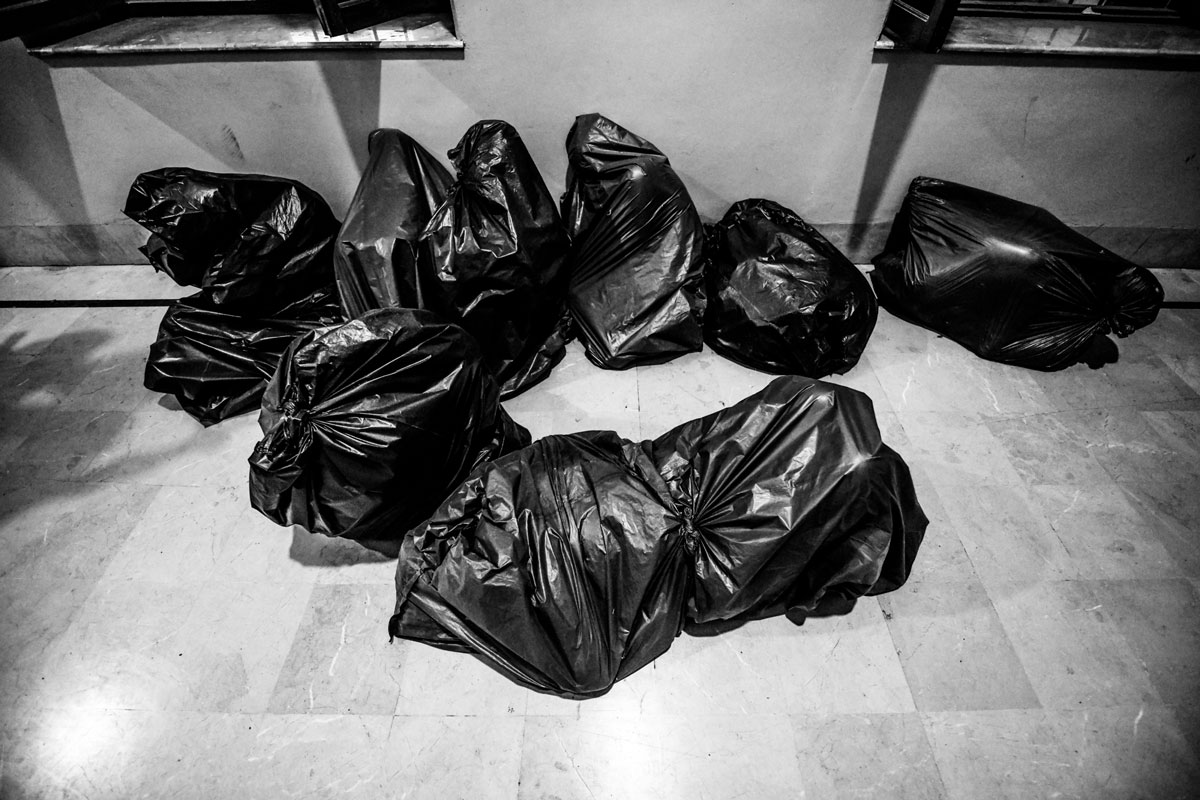
Any Last Words, 2017.
Performance

Kongo Astronauts
Born Kinshasa (Democratic Republic of Congo), 2013.
Live and practice where time and place allow
Kongo Astronauts
Born Kinshasa (Democratic Republic of Congo), 2013.
Live and practice where time and place allow
Brought into being in 2013 by artists based in Kinshasa, the capital of the Democratic Republic of Congo, Kongo Astronauts navigates the vertigo of multiple, parallel worlds. Faced with the violence of today’s robotically enhanced planet, Kongo Astronauts responds with art. Never fixed – for it is a collective whose membership is ever in flux – Kongo Astronauts builds upon differences and upon the confrontation of diverse experiences, corralled, all, in an attempt to resist the psychological ghettos that characterize lives lived in the postcolonial era. Kongo Astronauts manifests in the interzones of digital globalization, wherein past, present and future collide, impacting politics of intimacy and identity in urban and rural settings alike. At work and play in the field of post-disciplinary action, Kongo Astronauts materializes in cosmic appearances and polysemic fictions (performances, films, texts, photos…), immersing viewers/listeners/bystanders in a multidimensional engagement with the experience of exile and the quest for survival.
SPARCK has chosen to show three films by the Kongo Astronauts collective, all associated with a series titled Postcolonial Dilemna. All three speak to the artists’ refusal to take at face value the world they inhabit and their insistence on seeking out alternative ways of engaging with and bypassing its political, economic and psychological violence. The third film, Postcolonial Dilemna Track #03 (Unended) is properly oneiric. An astronaut ambles through a tropical forest, making his (her?) way toward a massive waterfall. The astronaut is a key protagonist in several of the collective’s “works”: unscripted performances in the streets of Kinshasa, an ever-expanding series of photographs by Kongo Astronauts and by others, films such as the one seen here, music videos (for example by Congolese rapper Baloji and new and upcoming Kinshasa-based group Mbongwana Star). The astronaut is a perplexing persona, unnamed, mysterious, ever changing, as the artists transform her/his appearance. Here, the notion of the cyborg exits the realm of science fiction to enter that of the every-day world, questioning in richly poetic image-ways terms of engagement with a post-capitalist order determined to do away with such exquisite spaces as the landscape the astronaut is traversing.

Still from Postcolonial Dilemna Track #03 (Unended), 2014.
Video, 6:31 min.
© Kongo Astronauts
Courtesy of the artists
Curated by SPARCK.
(LA) HORDE
Founded 2013
(LA) HORDE is a collective of three French artists: Marine Brutti (b. 1985), Jonathan Debrouwer (b. 1985) and Arthur Harel (b. 1991). Together, they develop their practice through stage direction, filmmaking, video installation, choreography and performance. After creating a choreographic piece for Seniors (Void Island) and another one for future graduates of ECDMTL (Avant les gens mouraient) in 2014, the artists were invited to create a film and performance at the International Biennale of Design in Saint Etienne, France. This film, Novaciéries (2015), has been projected at the Centre Pompidou, IFFR, Slamdance and Clermont-Ferrand. In 2016, (LA) HORDE created a new show on Hard-Dances titled TO DA BONE, which won second prize at Danse Élargie at the Théâtre de la Ville in Paris. The show had its premiere at the FTA festival in Montreal in 2017. Between 2016 and 2017, (LA) HORDE was commissioned to make a number of videos, including Larger Than Life in 2016 and Cloud Chasers for the Fondation d'entreprise Lafayette in 2017. The collective’s leitmotiv is to question and swap the codes of different artistic scenes for contemporary art and living art.
Larger than Life is the result of a four hour-long performance. The artists chose to drag out the length of production to suggest an intimate gathering that lasts several hours. Taking the idea of a family reunion as a point of departure, (LA) HORDE created a minimalist setting of a dinner table. As this dance-based video opens, men and women are seen gathered around the table. One by one, they gather on top of the table and begin to dance, directly engaging the viewer by approaching the camera and staring into it, seemingly energized by this outside engagement. Further exploiting the idea of voyeurism, (LA) HORDE included those watching the production of the video in the video itself: The audience was both assisting the video and participating in it. Throughout this time, the participants move both in unison and alone, producing a continuous movement in which the body can again and again reinvent itself. As the video ends, the table is folded up and taken away; the dancers are left frozen in place and seemingly together, but in their own thoughts. By using “datamoshing” during the editing process, the collective superimposed new designs, shapes and imagery upon existing ones in order to emphasize the concept of fluidity.

Still from Larger Than Life, 2016.
Video, 5:55 min.
Courtesy the artists
The presence of this artwork was made possible by French liaison Abi Tariq, with support from Cité Internationale des Arts, Paris
Lala Rukh
1948 (Lahore, Pakistan) – 2017 (Lahore, Pakistan)
Lived and worked in Lahore (Pakistan)
Lala Rukh studied art at Punjab University, Lahore, Pakistan (MFA) and University of Chicago, USA (MFA). She taught for 30 years at Punjab University, Department of Fine Art and at the National College of Arts, Lahore where she set up the MA (Hons) Visual Art Program in 2000. Rukh also trained in Islamic calligraphy and studied musical traditions from across the Indian subcontinent. She was actively engaged in archiving the All Pakistan Music Conference, which was initiated by her father, Hayat Ahmad Khan, in 1959. Rukh is primarily known for her drawings and print-based works, which reflect the patterns of both calligraphy and music. But she is equally recognized for her roles as an educator and activist for women’s rights. Beginning in the Zia regime (1977-1988), which was a particularly hostile one towards women, Rukh was a vocal member of the Women’s Action Forum. Her commitment to the disenfranchised never abated throughout her long career. Rukh’s shows include LISTE – Art Fair Basel 2017, Basel, Switzerland; “sagar,” Grey Noise, Dubai, UAE; “For an Image, Faster Than Light,” curated by Bose Krishnamachari, Yinchuan Biennial, Yinchuan, China; “but even if I cannot see the sun,” Grey Noise, Dubai, UAE; “The past, the present, the possible,” curated by Eungie Joo, Sharjah Biennial 12, Sharjah, UAE; and Documenta 14 in Athens, Greece and Kassel, Germany.
Hundreds of lawyers call out in unison for the independence of the judiciary under General Pervez Musharraf. Recorded during demonstrations in Lahore and Islamabad, the voices heard in this sound piece from 2008 (the title translates as “Dawn of Hope” in English) eulogize the struggle of the lawyers themselves, of women’s organizations, the media and student groups. Waves of urban sound succeed one another: morning rain and bird calls move into slogans and songs, ending in a classical ragga piece, upbeat and akin to a dance, performed by singer Sarah Zaman, an active participant in the demonstrations. As Rukh wrote to a friend at the time of the lawyers’ protests, which began in 2007, “This movement has truly captured the imagination of the people. It has given rise to poetry and graphics, slogans and slogan leaders who can carry on adlibbing nonstop for 15-20 minutes. One slogan leader is a woman lawyer who when she starts walks backwards, facing the demonstrators, and never falters either in her step or the rhythm of the slogans."

Li Wei
Born in 1970 in Hubei (China)
Lives and works in Beijing (China)
Li Wei’s artistic practice is a dynamic amalgamation of performance art and photography. Using acrobatics, props, cranes and wires, the artist surprises the viewer with dramatic, often amusing performance installations that depict him in photographs in gravity-defying situations, giving the impression of flight. Li Wei’s work has been widely shown across the globe, including: the 55th Venice Biennale; the Katonah Museum of Art, United States; the Beijing Times Art Museum, China; the Daegu Photo Biennale 2010 in South Korea; the Palazzo Reale Museum, Milan; the Olympic Museum, Switzerland; the Criterion Gallery, Australia; the Toulouse Art Museum, France; the Ox Warehouse, Macau; the Prague Biennial 2003; the Beijing Red Square; the Hong Kong Arts Center; and the Performance Art Festival, Beijing. His impressive résumé also includes many solo exhibitions, including: Parc de la Villette, Paris; 10 Chancery Lane Gallery, Hong Kong; Shanghai Tang, Hong Kong; Tribeca, Madrid; Michael Schultz Gallery, Beijing; Mogadishni CPH Gallery, Denmark; Yeh Rong Jia Culture & Art Foundation, Taiwan; EScape Cultural Ample Gallery; PYO Gallery, Seoul; Galeria Espacio Minimo, Madrid; and Marella Gallery, Italy.
One of the photographs selected for the Karachi Biennale 2017, Boxing, embodies Li Wei’s artistic practice, depicting the artist himself falling from a skyscraper in Beijing during an apparent bout with another figure. The timing of the photograph, along with its composition, are immaculate; the artist is seen at the point of the punch’s impact, an act of violence, falling backwards off an edificial precipice, the bottom of which neither the artist nor the audience can see, imbuing the photograph with a sense of fear and danger. Li Wei’s matching chequered costume blends in with the surrounding buildings, confirming the reality of this danger by implying that he is soon to become a part of the architecture. The fact that the artist’s work is not an illusion created by careful editing on a computer, but partially a performative piece, forcibly provoking the viewer’s instinctive reactions to such visceral visual stimulus, subverts the justified cynicism that pervades our perception of photographic media in contemporary society.

Boxing, 2009.
Photographic print, performance
176 x 366 cm.
Courtesy the artist
Lucila Quieto
Born in 1977 in Buenos Aires (Argentina)
Lives and works in Buenos Aires (Argentina)
Lucila Quieto studied photography at the Escuela de Fotografía Creativa, Buenos Aires subsequently used photography, painting and collage as part of her artistic practice. Her work, Arqueología de la ausencia (Archeology of Absence, 1999-2001), has been exhibited in many countries, including Argentina, Italy, France and the UK. Her work has also been included in many joint exhibitions with other artists who are also children of disappeared parents, including Amontonados: Temporalidades de la infancia (2010), Anacronías (2011), Familias Q’heridas (2011), and Ficciones: Imágenes que construyen sentidos sobre el pasado (2017). In 2010 she co-founded Colectivo de hijos, a group of children of disappeared parents who, through art groups such as the Club del Collage and published books, have tried to influence public policies directed at the relatives of victims of the 1976-1983 Argentine dictatorship. Currently she works in the photography section of the Archivo Nacional de la Memoria, located in the former clandestine torture and detention center, the ESMA.
Carlos Alberto Quieto disappeared five months before the artist’s birth. In Arqueología de la ausencia, on view at KB17, Quieto combines fiction and biography, as well as performance and photography, to explore the disappearance of her father. Rather than just focusing on her own family history, however, she also invited other children of disappeared parents to participate in the work, placing an advertisement in a branch of HIJOS (Hijos por la Identidad y la Justicia contra el Olvido y el Silencio) with the following tempting offer: “Now you can have the picture you always wanted.” Quieto remembers: “I asked every son or daughter to look for a photograph of their parents. I then reproduced the images as slides. I projected them on the wall and asked the children to insert themselves between the camera and the image.” The experiment resulted in 35 black-and-white photographs each showing a playful and fictional scene that imagines alternative futures for those families. The images of Arqueología de la ausencia are thus answers to a disturbing question: what might have happened had the disappeared survived? Quieto’s montages speak of a time that is neither in the past nor in the present but in what she calls “a third time,” an invented, dream-like temporality, a dimension where everything, even the impossible, seems plausible.

Arqueología de la ausencia, 1999-2001.
Analog photography digitally reproduced
224 x 30 cm.
Courtesy the artist
Photograph of the artist by Kaloian Santos Cabrera
Curated by Carlos Acero Ruiz.
Madeeha Iqbal
Born in 1989 in Lahore (Pakistan)
Lives and works in Lahore (Pakistan)
Madeeha Iqbal is a multidisciplinary artist who works in a variety of mediums, spanning from installation to painting, sculpture to digital media. She completed her BFA, with Honours, from The Institute of Design and Visual Arts, Lahore College for Women University in 2012, then proceeded to complete her one-year Professional Diploma in Calligraphy and Illumination at the National College of Arts, Lahore. She obtained her MA Hons in Visual Arts from the National College of Arts in 2016. Her work has been widely exhibited locally, and she has been part of two international collaborative projects for the Emergent Art Space Online Gallery. Despite her training as a painter, Iqbal is constantly experimenting with her technical practice, exploring new means of creating a multi-layered visual discourse. She incorporates non-traditional materials in her work to endow it with a sense of spontaneity and creative dynamism, applying this to her interest in the continuous, natural dialogue in which we engage with our surroundings.
Iqbal demonstrates her innovative approach to medium in her untitled sculptural installation for the Karachi Biennale 2017. In her work, she synthesises two disparate interpretations of the commonplace: one, in the sense of feminine accoutrement; the other, in medical equipment. By inserting hypodermic needles into the very fabric of the handbag, bodyshaper and shoes, she amalgamates and transforms both sets of everyday objects, creating a strangely uncomfortable, anomalous whole. Iqbal’s novel use of ordinary objects also raises questions of the societal pressures that women are forced face on a day to day basis – it encourages the viewer to place themselves inside the work, evoking a subtle yet penetrative empathy.
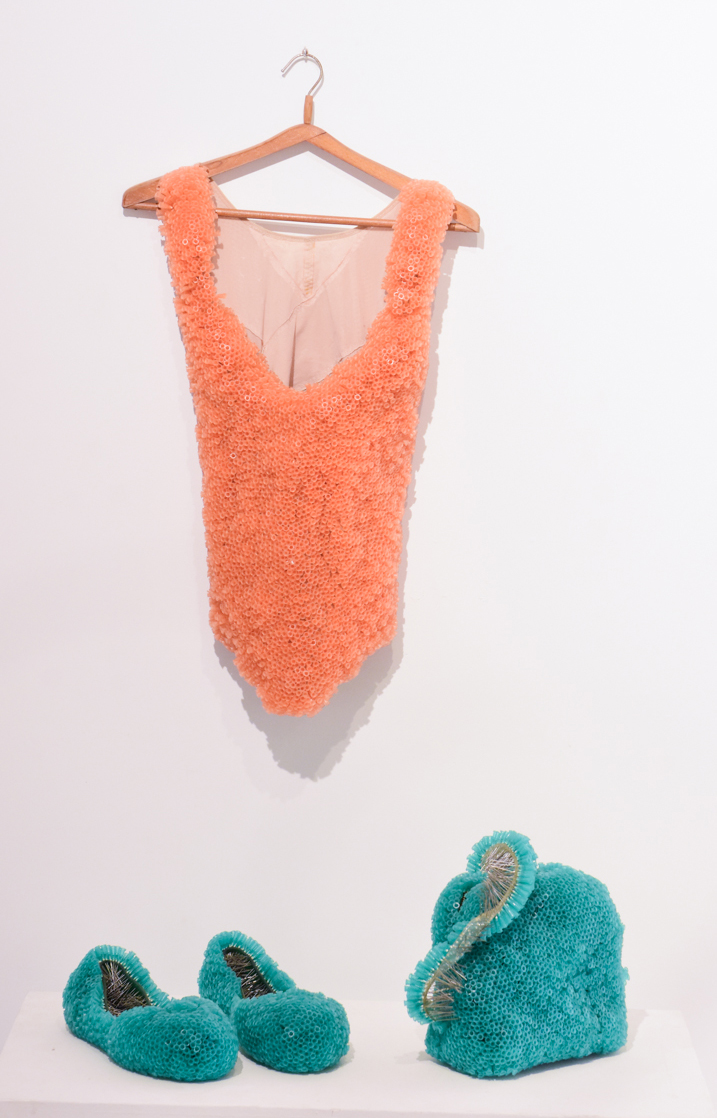
Untitled, 2017.
Hypodermic needles, shoes, handbag, bodyshaper
30 x 36 x 20 cm.
Courtesy the artist
Madiha Aijaz
Born in 1981 in Multan (Pakistan)
Lives and works in Karachi (Pakistan)
Madiha Aijaz works with photography, film and fiction. A recipient of the Fulbright Scholarship, she holds an MFA in Photography & Related Media from Parsons – The New School for Design. Her photographic work on Hindu temples in Pakistan was published in, Historic Temples in Pakistan – A Call to Conscience, in 2014. She is currently developing a documentary feature on travelling fairs and performers in Pakistan, in collaboration with film-maker Maheen Zia, which has received support from Locarno’s Open Doors Programme and the IDFA Bertha Fund. Aijaz works as an Assistant Professor at the Indus Valley School of Art and Architecture, Karachi. Aijaz’s art practice explores the liminal zone between fiction and reality that the camera, as a vehicle of representation, often accords. Photographically, she aims to read and transpose the instinctual unconsciousness in its unfolding, simultaneously investigating the veracity and theatricality of her subject, imbuing her work with a veristic equivocality that corresponds to our own ocular experience of the world.
Aijaz’s work for the Karachi Biennale 2017 studies the public libraries of Karachi and the librarians who have been obstinately holding the fort at such institutions whilst the context of the city has transformed, in many cases, around them. This emphasis on the librarians themselves provides an insight into the migrant communities of the city, as well as the aging intelligentsia – many of whom are bastions of a foregone era. Such a study, working in a combination of photography, film and text, is also a reading of the shifting context that has shaped the content in the libraries; the content being a tangible barometer of the city’s cultural trajectory throughout the years. The work itself is part of the fabric of the shelves in the Theosophical Society’s Library, one of the oldest public libraries that remains in Karachi, with publications dating back to the 1890s, perfectly consummating Aijaz’s concept and its realisation, with the artwork becoming a part of the library.
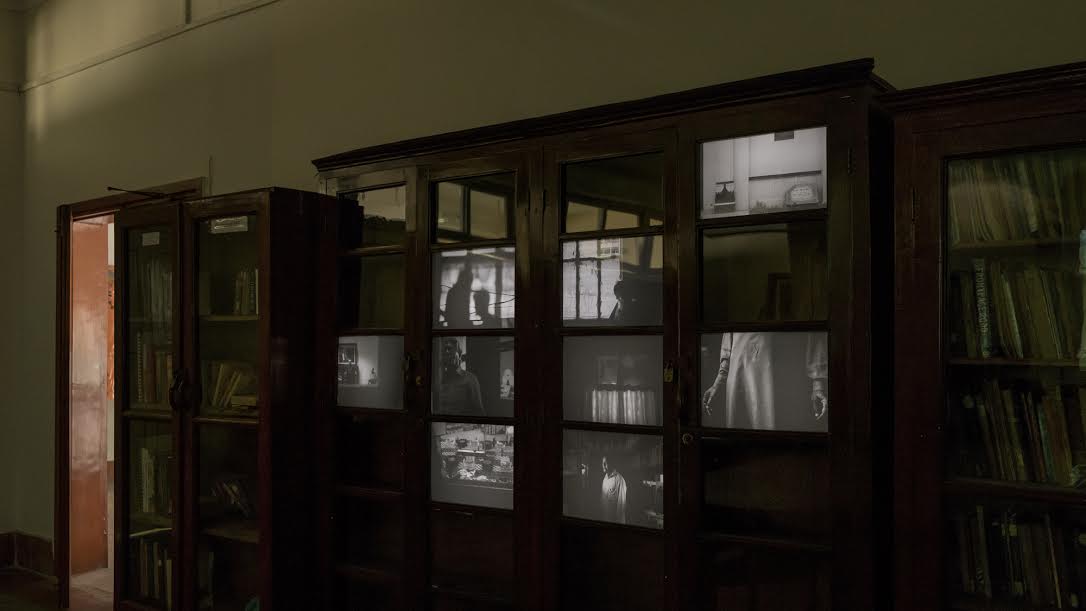
These Silences Are All the Words, 2017.
Photographs and a two channel video projection
Courtesy the artist
Mahbub Jokhio
Born in 1992 in Mehrabpur (Pakistan)
Lives and works in Lahore (Pakistan)
Mahbub Jokhio graduated with distinction from Beaconhouse National University in Visual Arts as a UMISSA scholar, and currently teaches at the National College of Arts, Lahore.. Utilising a variety of mediums and spanning diverse subject matter, his work hinges on the explicit appropriation and incorporation of conflicting signs, symbols and illusory indexes, drawing into question patterns of perception and intention in their ambiguity. Jokhio’s work has been shown in a variety of exhibitions, at venues including: IVS Gallery, Karachi; TAG, Lahore; Canvas Gallery, Karachi; and Alhamra Art Gallery, Lahore. He was also recently awarded a Gasworks Residency in London.
In Jokhio’s site-specific installation for the Karachi Biennale 2017, Jese Shahr-e-Madfoon Py Waqt Guzray!, the artist has recreated a children’s graveyard, constructing the graves out of mud, bricks and plastered with cement. The vibrant, gaudy colour scheme of the graves belies the sombre subject matter, epitomising Jokhio’s aesthetic discourse between images and their epistemology. The way in which the work’s bright and colourful final manifestation is unable to be separated from the basis of its subject matter, replicating the form of children’s final resting places, visually represents the inseparability of life and death in the human experience. Simultaneously, it analogously comments on the failings of the Pakistani education system, suggesting that the superficial concealment of these flaws does not change the collective realities of the children that it has failed.
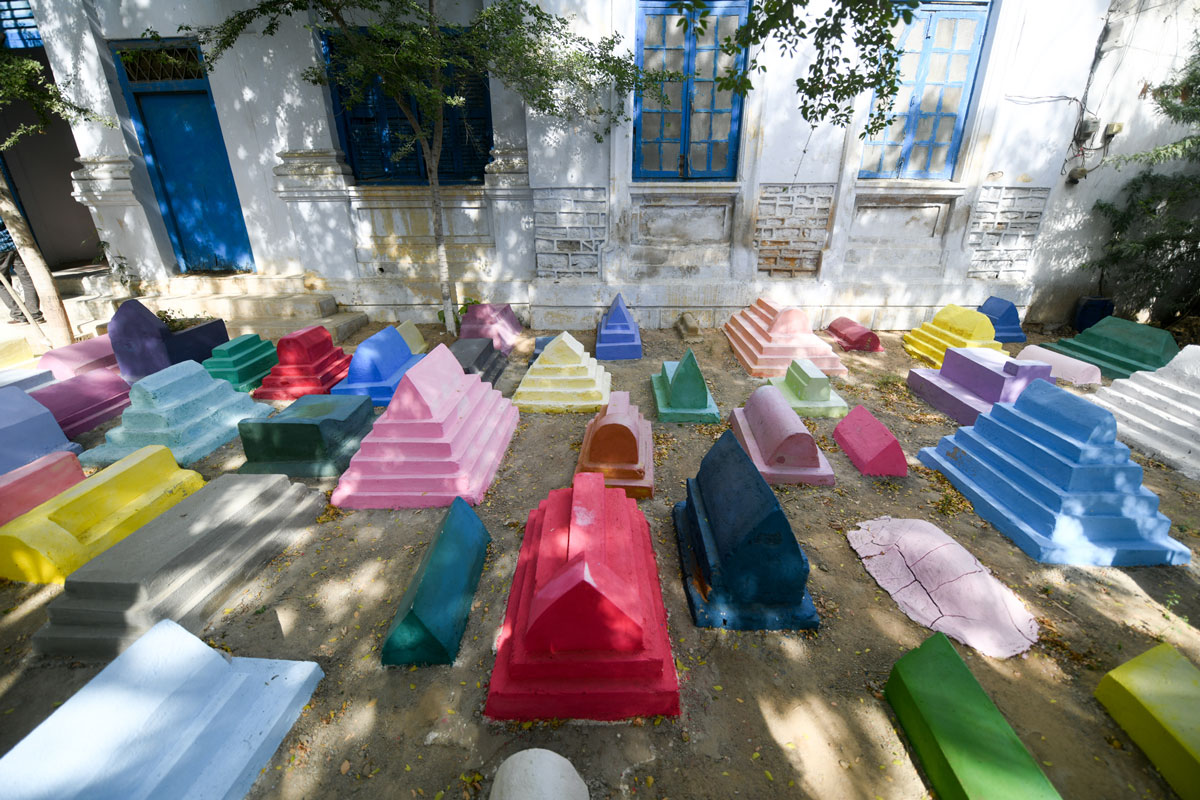
Jese Shahr-e-Madfoon Py Waqt Guzray!, 2017.
Bricks, cement, mud, synthetic enamel and emulsion
Dimensions variable
Collection of the artist
Malala Andrialavidrazana
Born in 1971 in (Madagascar)
Lives and practices in Paris (France)
By way of the photographic medium, Malala Andrialavidrazana’s practice interrogates barriers and interactions within cross-cultural contexts, thoughtfully shifting between private spaces and global considerations to explore social imaginaries. Based on extensive in situ as well as bibliographic and archival research, her visual compositions open up the possibility of alternative forms of storytelling and history-making. Andrialavidrazana graduated from La Villette School of Architecture (Paris) in 1996. Her d’Outre-Monde series was awarded the prestigious HSBC Prize for Photography, and released in print by the renowned Actes Sud publishing house in 2004. She received the joint support of the Institut Français and the National Arts Council of South Africa for her series Echoes (from Indian Ocean), published in 2013 by Kehrer Verlag. At the moment, Andrialavidrazana is at work on an ongoing series titled Figures, highlighted in the present installation. Over the past years, Andrialavidrazana’s work has been exhibited in numerous international venues. Recently, these have included: Bamako Encounters (Mali 2015); Museum of Natural History (Le Havre, France 2016); Kehrer Galerie (Berlin 2016); Changjiang International Photography & Video Biennial (Chonqing, China 2017); Kalmar Konstmuseum (Kalmar, Sweden 2017); PAC Milano (Milan 2017); Lyon Biennial (Lyon 2017); C-Gallery (Milan 2017); 50 Golborne (London 2017).
Figures is the title of Malala Andrialavidrazana’s most recent series of works, an ongoing project initiated in 2015. In the present installation, the works are shown as large-scale projections. This is unusual; typically, they are displayed as physical prints over one meter in height. Overlays of 19th and 20th century maps, bank notes and stamps cut, reshaped and rethought by the artist, give rise in Figures to novel cartographies that speak powerful truth to power. Individually and as a unit, the resulting works highlight falsehoods inherent in the colonizing powers’ claim to objective and rational “knowledge” – to the North’s (ongoing) deployment of science as a weapon in the subjugation of peoples and territories. Clichés, pre- and misconceptions are at once subtly and incisively brought to the fore, as are fundamental misunderstandings as to how maps function and to what ends. The resulting works demand of the viewer that s/he (re)consider her position not only as a subject gazing at a work of art, but also as an actor in the forging of a world riven with the violence of power relations.

Figures 1853, Kolonien in Afrika und in der Süd-See, 2016.
Pigment Print on Hahnemühle Cotton Rag, 110 x 151,5 cm
© Malala Andrialavidrazana
Courtesy of the artist, 50 Golborne – London, Afronova – Johannesburg, C-Gallery –Milan, Kehrer – Berlin
Curated by SPARCK.
Mandarjazail Collective
Founded in 2015
The Mandarjazail Collective are Abdul Fateh Saif (b. 1990, Lahore), Fahad Naveed (b. 1990, Karachi), Shahzaib Arif Shaikh, (b. 1990, Hyderabad) and Veera Rustomji (b. 1992, Karachi). They are a group of visual artists hailing from a variety of creative disciplines, including: architecture; graphic design; textile design; photography; filmmaking; and fine art. Having been founded by a group of five like-minded creative individuals in 2015, the Collective now comprises twenty-three members, and continues to evolve with the addition of each new member. The Mandarjazail Collective represents a platform for symbiotic artistic relationships and dialogue, from which they provide one another with support, guidance and inspiration. They held their first show, ‘Excerpts’ at Koel Gallery, Karachi, in 2016, and are currently exploring various national and international opportunities.
The Mandarjazail Collective’s work for the Karachi Biennale 2017, comprising of four large scale photographic portraits of the four members – Abdul Fateh Saif; Fahad Naveed; Shahzaib Arif Shaikh; and Veera Rustomji – is an artistic investigation into the powerful role that heavily-circulated images play in the formation of our essentialised perception of beauty and identity. The basis of the work’s subject matter is the ubiquitous fame of Steve McCurry’s image of the ‘Afghan Girl’, Sharbat Gula, which was published on the cover of National Geographic in its June 1985 edition. After the publication and mass-circulation of her piercing gaze, an image that is recognised throughout the world, Gula unwittingly became the symbol of the Afghan refugee crisis. The Mandarjazail Collective have placed themselves within this paradigmatic exemplar of the power of the media to utilise photographs to characterise and create a trajectory for an anonymous individual, questioning the ethical implications of witnessing sweeping narratives through the media’s prying lens. The scale of the works becomes a visual metaphor for the intense circulation of the media’s photographic currency, whilst the element of self-portraiture raises the almost existential concern with the fact that in global culture, one thirteen-year-old girl can be seen as representative for a whole population – for Sharbat Gula shall be known in posterity as the ‘Afghan Girl’.
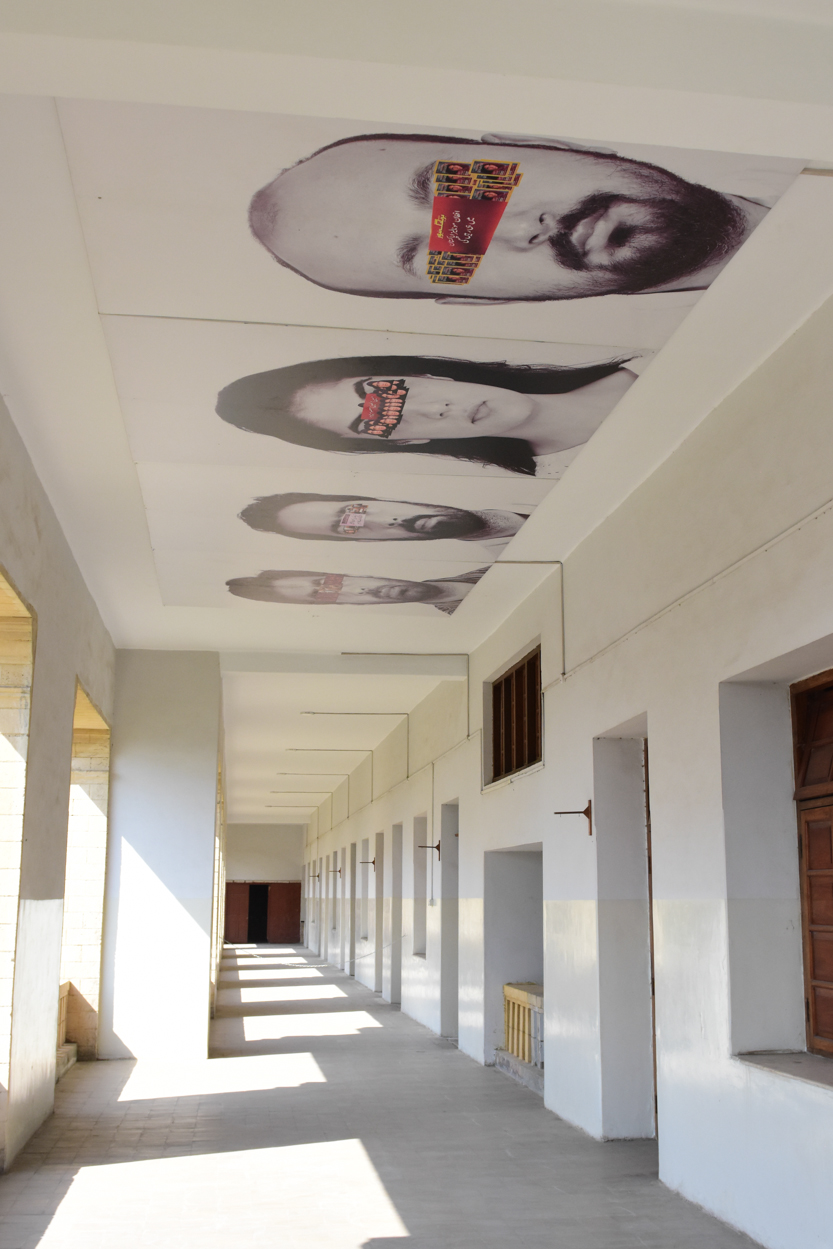
Starry-eyed, 2017.
Photography, print on Panaflex
426 cm x 416.5 cm
Manizhe Ali
Born in 1972 in Lucknow (India)
Lives and works in Karachi (Pakistan)
Manizhe Ali has a MA in Visual and Media Anthropology from Freie Universität, Berlin and a BFA from the Indus Valley School of Art & Architecture, Karachi. She is a multi-disciplinary artist who works in various medium such as painting, video, photography, installation and performance and has exhibited her work both nationally and internationally. She has worked for Indus Vision Television Network and Geo Television Network. She was on the organizing committee for KaraFilm Festival and is an alumnus of the Berlinale Talent Campus. In addition, she has her own jewellery brand. Currently Manizhe is the Director at ZCOMS (Ziauddin College of Media Sciences), Ziauddin University. Formerly she has been associated as an academician and HOD with Indus Valley School of Art and Architecture and Iqra University.
Manizhe Ali writes of her performance for KB17: “Every day our brain stores, encodes and retrieves memories. In this performance, the artist is both the protagonist and the observer. Visitors are invited to share a memory on a piece of paper which is then added to the pile of growing memories on the floor. As the memories accumulate the artist is slowly surrounded by them and in this way, the memories are both shared and preserved.”
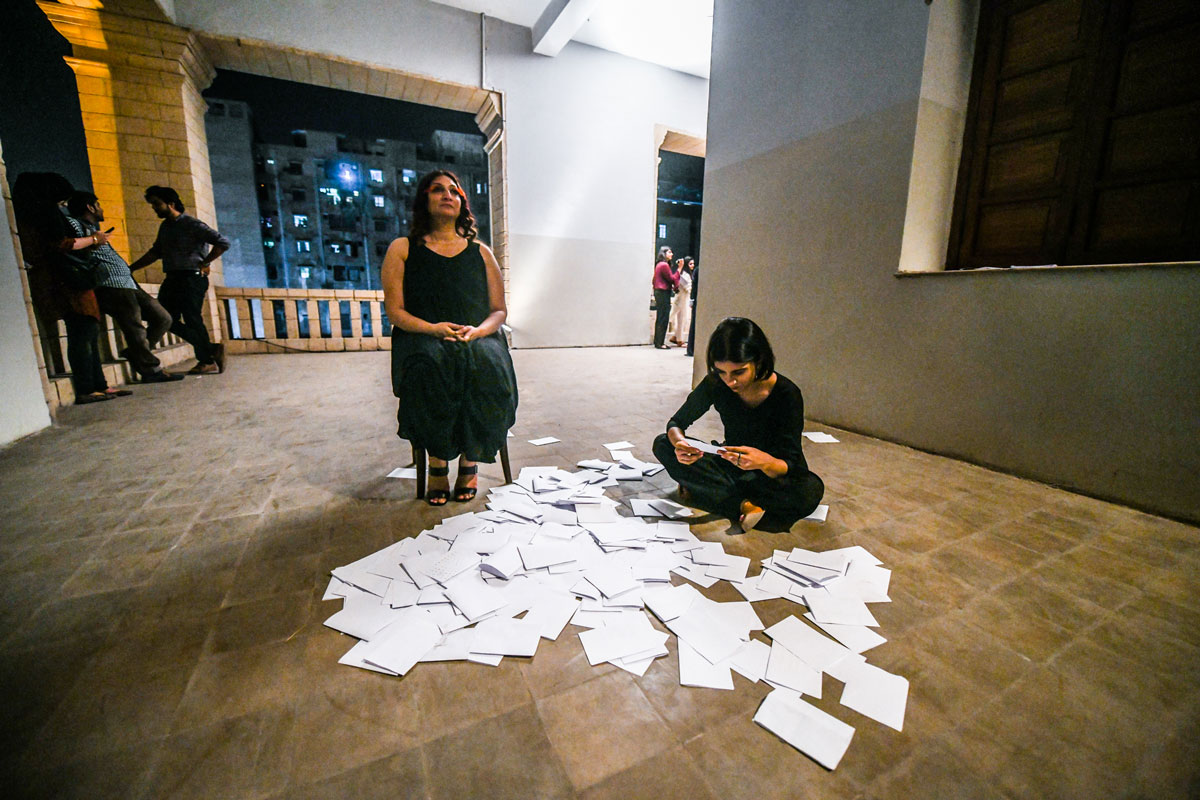
Being There, 2017.
Performance
Marco Nereo Rotelli
Born in 1955 in Venice (Italy)
Lives and works between Venice and Milan (Italy)
Marco Nereo Rotelli was trained in architecture in Venice. For years he has researched light and the poetic dimension, which Harald Szeemann has defined as “an expansion of the artistic contest.” He has worked with philosophers, musicians, photographers and film directors. But his primary interest remains in the relationship between art and poetry, which has become a constant reference in his work. In 2000 he founded the group Art Project, directed by Elena Lombardi and composed of young artists and architects; together they have realized numerous interventions and urban installation projects. Rotelli has participated in eight editions of the Biennale di Venezia, as well as numerous individual and collective exhibitions. His works are in important museums and private collections all over the world.
Marco Nereo Rotelli writes of his installation on view at KB17: “These long flags are spiritual and existential spaces. The way I see it, poetry is not just poetry for its rhymes and contents. From the art point of view, it is the possibility of visuals in the world of words, even a possibility to think the sound and the space in the time of a verse. These fabrics are like standards which wave the rights of humanity.”
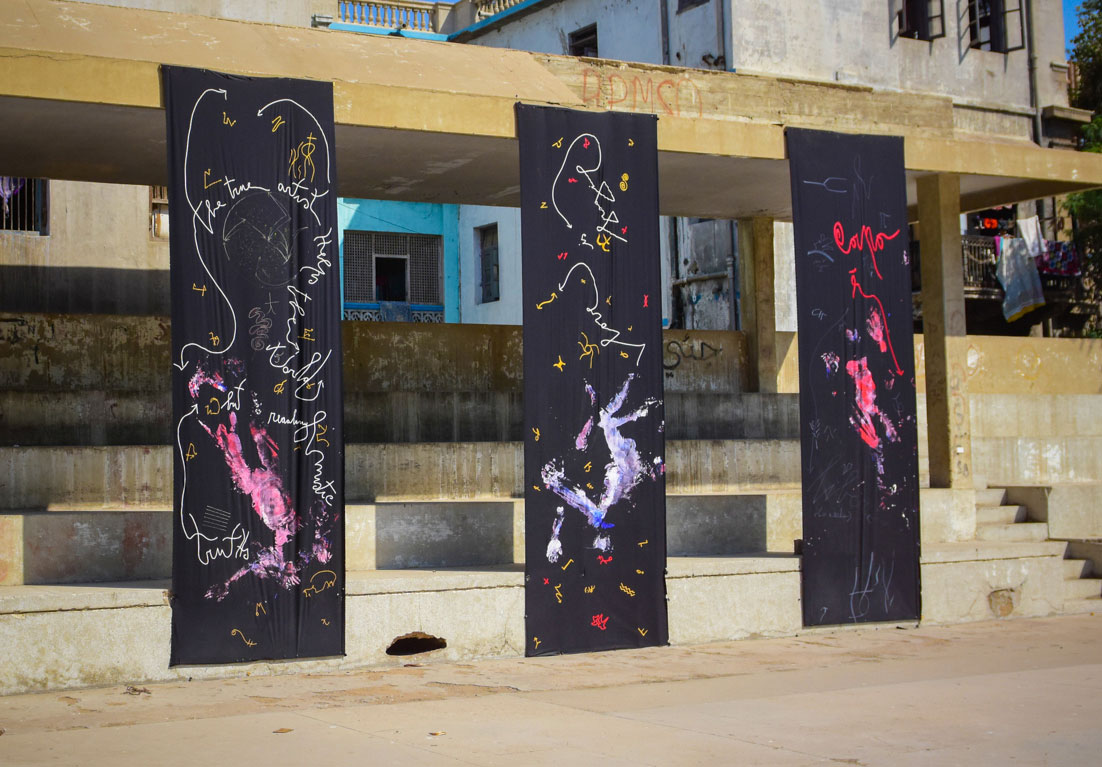
The Way of Being, 2010.
Tempera on wool Reda fabrics
300 x 150 cm each
Courtesy the artist
Curated by Paolo De Grandis.
Matilde Marín
Born in 1948 in Buenos Aires (Argentina)
Lives and works in Buenos Aires (Argentina)
Matilde Marín’s work revolves around what she calls “the internal memory of man.” Her current production is focused on the role of the artist as a witness, recorded through photography and video stories about the world we inhabit, situations that relate to pure landscape as well as its natural or artificial alteration. The artist has exhibited widely both in Argentina and internationally. She participated in the 2015 XII Biennial La Habana, Cuba and the XX Biennial de Curitiba, Brazil and received the Biennial Award of Puerto Rico and Bienal de Cuenca, Ecuador. Marín was also bestowed with the Jorge Romero Brest Award by the Argentina Association of Art Critics and the Platinum Konex Award. Her work can be found in the collections of Malba, Museum of Latin American Art, Buenos Aires, Argentina; Bronx Museum of Art, New York, USA; and Contemporary Art Center Reina Sofia, Madrid, Spain.
Adriana Almada has written of the work by Matilde Marín, on view at KB17: “To record images of fumes is to stop the course of history and make all bonfires one. In the same way that Bertolt Brecht extracted from newspapers maps and scenes of the Second World War and mounted them in his Arbeitsjournal (Labor Diary), or as Aby Warburg long before did with his Atlas Mnemosyne, inviting a re-reading of European civilization from a free association of images, Matilde Marín collected (2005-2011) hundreds of photographs of different ’fumes’ -with their respective legends- appearing in the press. To read them is to get an overview of our convulsive times…Smoke is usually the rubric of a catastrophe; the list is endless. The epigraphs change, but the smoke remains. Other and more recent fumes are shown on the move -also confirming the end of an era-, such as the spectacular implosion of Kodak Building 53 (July 18, 2015) -which manufactured the acetate base of photographic film in Kodak Park, Rochester, USA.”
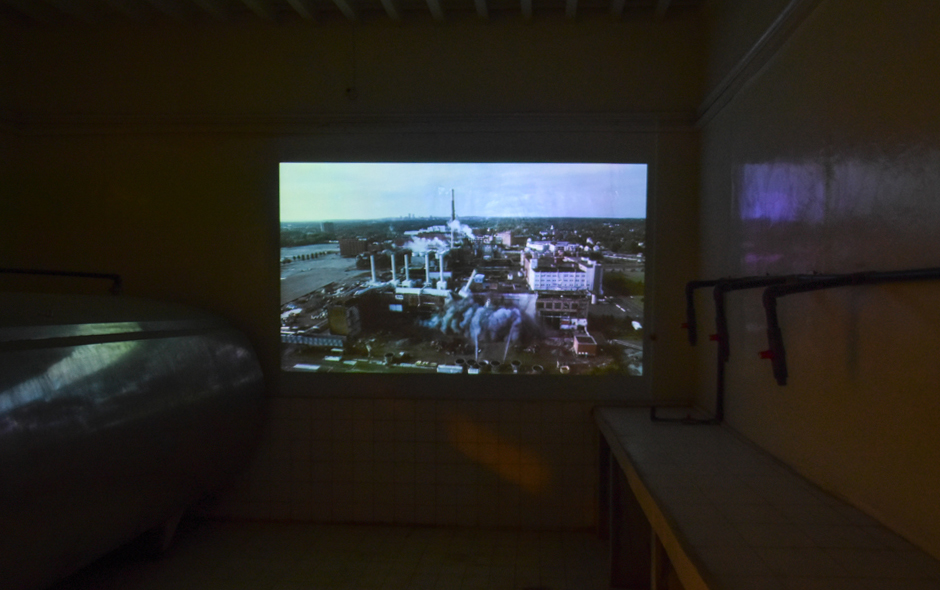
Factory, 2017.
Post production video, 1:00 min.
Courtesy the artist
Max Papeschi
Born in 1970 in Milan (Italy)
Lives and works in Milan (Italy)
After working as a writer and director for theatre, TV and cinema, Max Papeschi turned his attention to digital-art. Since then, no political or cultural figure has been spared his scathing wit, whether it be Kermit the Frog, Josef Stalin, Mickey Mouse, Adolf Hitler or Hello Kitty. Papeschi has had numerous exhibitions all over the world.
Flavia Vago has written of Max Papeschi’s work on view at KB17: “In 2016 Max Papeschi realized his work IT’S ALL DEVO in digital animation technique for his friend and collector, Gerald Casale. Casale is a member of DEVO, a revolutionary American band that is a symbol of New Wave...Casale asked Papeschi to make a music video, which he did, in collaboration with Maurizio Temporin…[in it] a dystopian reality is presented; a mass of horrific characters who represent the most disturbing aspects of our contemporary age.”

Still from IT’S ALL DEVO, 2016.
Digital animation, 3:30 min.
Courtesy the artist
Curated by Paolo De Grandis.
Mayra Martell
Born in 1979 in Ciudad Juárez (Mexico)
Lives and works in Mexico City (Mexico)
Mayra Martell is a documentary photographer from Ciudad Juárez, Mexico. She has worked primarily in areas of Latin America and Africa subjected to forced disappearance. Her largest projects in Latin America include Falsos positivos (2009), Cerro de Petare (2007), and Ensayo de la identidad (2005-2010). Falsos positivos, carried out in the impoverished outskirts of Bogota, documents the tragedy of young men who were kidnapped, killed, and presented as guerrilla casualties by the Colombian army. Cerro de Petare portrays everyday life in one of Caracas’ biggest and most violent slums. Ensayo de la identidad is a five-year project about the disappearance of women in Ciudad Juárez, a city whose social fabric has been torn by violence. Martell has received many distinctions and awards. At the 4th International Photobook Festival in Kassel, Germany, she won first prize in the Reviewer Award 2011 and second prize in the Dummy Award 2011. She is currently working on a project called Sexy Mafia which proposes an exploration of the concept of beauty in Culiacan, Sinaloa, Mexico´s main drug-trafficking city.
For KB17, Mayra Martell has presented work from her series on Ciudad Juárez and the Western Sahara. Of her Ciudad Juárez series, she writes: “It’s been five years since the downtown started to disappear, becoming a battleground for drug cartels, the scene of murdered women and the vanishing place for countless people. Ciudad Juárez is the paramount example of a society that is consuming itself without being able to stop. I believe that there is something there in those spaces that makes people forget that other places exist; as if one had no past, like the city itself. Perhaps I like it because it has no memory, or at least not one as obvious as other places where I’ve been. It’s as if it had collapsed and something broke inside; it’s like the life-essence of someone in disgrace, so overwhelmed by her loss that she has become stuck, stranded in the same place; a place of sadness. Juárez is like an old and abandoned kitchen; as the sun rises, buses can be seen roaming about like iron cockroaches crawling on a dirty, retched floor; a floor in ruins; a lonely floor.”

Downtown Ciudad Juárez, 2010-2015.
Digital photograph
90 x 60 cm
Courtesy the artist
Curated by Carlos Acero Ruiz.
Meher Afroz
Born in 1948 in Lucknow (India)
Lives and works in Karachi (Pakistan)
Meher Afroz’s reputation as a prolific printmaker and painter reflects modernity rooted in a traditionalist approach to image-making. Afroz completed her undergraduate studies in fine arts from the Government College of Arts and Crafts, Lucknow, India in 1971. She began her formal art practice in the early ’70s. She has drawn much appreciation and critical acclaim for her printmaking and painting. She is one of the foremost printmakers of her generation. Some of her most important series are The Mask and Puppet, (1988-89), Portrait (1990-91), Amulet (1992-3), Zindaan (2001), Pindaar (2002-3), Dastaavez (2007), Naqsh-bar-Aab (2012), and others. Her career spans a modernist approach that encompasses the abstraction of the picture plane into a layering of the surface, embedded with imagery and text. She was awarded the Pride of Performance by the government of Pakistan in 2015. Afroz co-founded ASNA in 1998, a collective for research, exhibition and dialogue of the local kumbhar, or clay artisan, with the mainstream studio potter/artist. She has taught art at the Indus Valley School of Art and Architecture, Karachi as well as workshops and short-term classes at the Central Institute of Arts and Crafts, Karachi. She has a long list of national and international exhibitions.
Meher Afroz responds to the theme of Witness in an abstract and non-literal manner, reflecting her larger art practice since the 1970s. As one in dialogue with the social through an indirect critique, the artist has constantly been bearing testimony to the value system in her surroundings. The questions that arise out of this dialogue between self and society question the legitimacy of narratives both in and outside the art world. The suspended masnad evokes an enquiry into many levels of witness, and provides a space to seek the physical and spiritual manifestation of its form. Bearing in mind its references in historical text and practices, this is an object of mediation, desire and holds the promise of a reward. The beauty associated with the richness of color and zardozi on textile provides a momentary anchor to reflect on the existing nature of shared spaces, dialogues and their subtext.
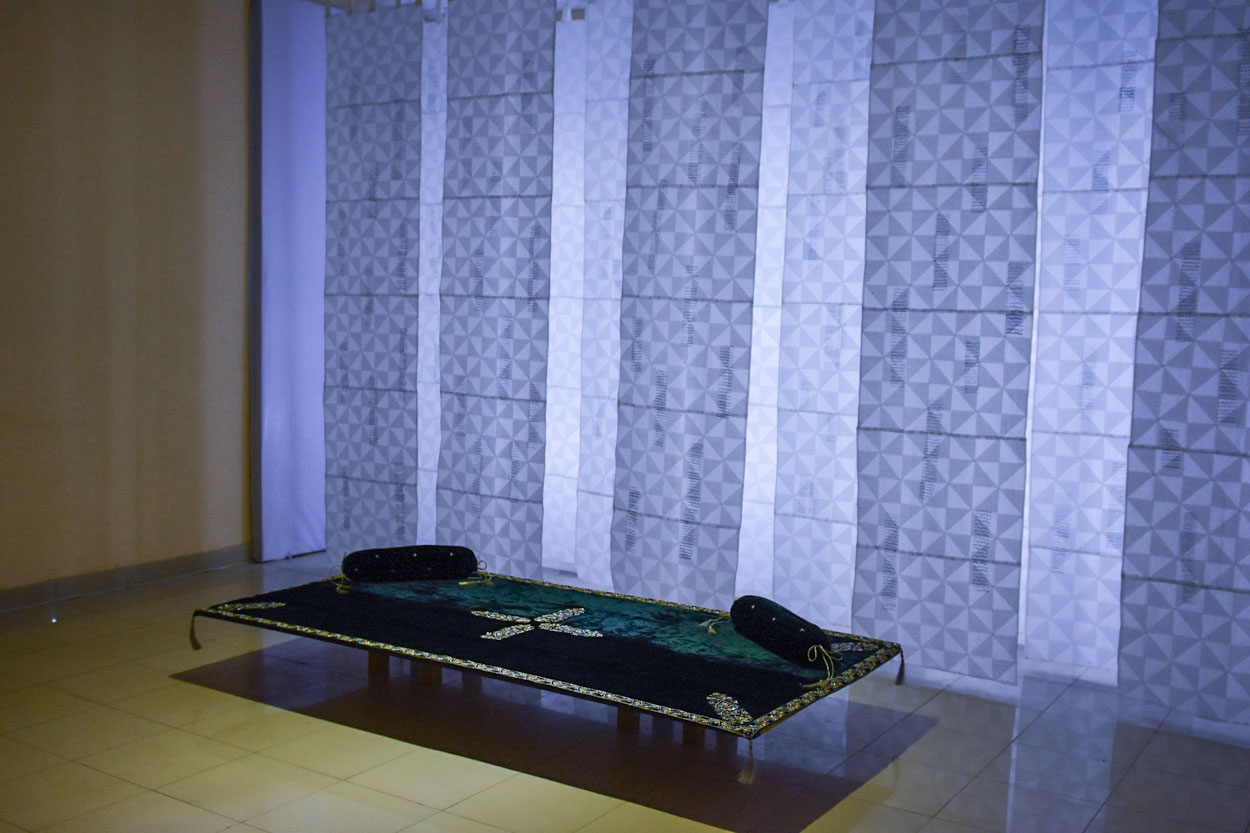
Witness as Continuity, 2017.
Mixed media
Dimensions variable
Courtesy the artist

Michelangelo Pistoletto
Born in 1933 in Biella (Italy)
Lives and works between Biella and Turin (Italy)
Michelangelo Pistoletto
Born in 1933 in Biella (Italy)
Lives and works between Biella and Turin (Italy)
A leading figure in the development of Arte Povera and Conceptual art, Michelangelo Pistoletto is well known for his “mirror paintings” beginning in the 1960s, which first used grounds of metallic paint on canvas before rejecting canvas entirely for polished steel. In 2003 he was awarded the Golden Lion for Lifetime Achievement at the Venice Biennale. At the same Biennale he presented Love Difference - Artistic Movement for an InterMediterranean Politic, a project born in April 2002 at Cittadellarte, for which Pistoletto made a large reflecting table in the shape of the Mediterranean basin, around which many of the subsequent activities of Love Difference took place. In 2004 Turin University graduated him with a laurea honoris causa in Political Science. On that occasion the artist publicly announced the most recent phase of his work, Third Paradise, whose symbol is a reconfiguration of the mathematical sign for infinity conceived by the artist in 2003. From 2007, with the collaboration between Pistoletto and the musician Gianna Nannini, curated by Zerynthia - RAM Radioartemobile, the Third Paradise evolved into a multimedia work in progress. In 2007, in Jerusalem, Pistoletto was awarded the Wolf Foundation Prize in the Arts, “for his constantly inventive career as an artist, educator and activist whose restless intelligence has created prescient forms of art that contribute to fresh understanding of the world.” In 2010 he wrote the essay The Third Paradise, published in Italian, English, French and German. In 2011 he was the artistic director of Evento 2011 – L'art pour une ré-évolution urbaine in Bordeaux. In 2012 he started promoting the Rebirth-day, first worldwide day of rebirth, celebrated every year on 21st December with initiatives taking place all around the world. In that same year he is bestowed the title of Grand Officer of the Order of Merit of the Italian Republic. In 2013 the Louvre in Paris hosted his personal exhibition Michelangelo Pistoletto, année un – le paradis sur terre. In this same year he received the Praemium Imperiale for painting, in Tokyo. In 2014 the symbol of the Third Paradise was installed in the hall of the headquarters of the Council of the European Union in Brussels for the period of the Italian Presidency of the European Council. In May 2015 he received a degree honoris causa from the Universidad de las Artes of Havana in Cuba for "his contribution to contemporary art and his influence on several generations of artists". In October of the same year he realizes a work, called Rebirth, in the park of the Palais des Nations in Geneva, headquarters of the UN, costituted of a huge symbol of the Third Paradise formed of 193 stones, one for each UN State Member.
Michelangelo Pistoletto states of his work for KB17: “The Third Paradise is the third stage of human society. The first is the ancestral stage dominated by nature, the second is the artificial stage dominated by art, science and technology. Today we are entering the third stage which will evolve in equilibrium between nature and artifice. Creating this equilibrium is the job we will do together, there is work for everyone."
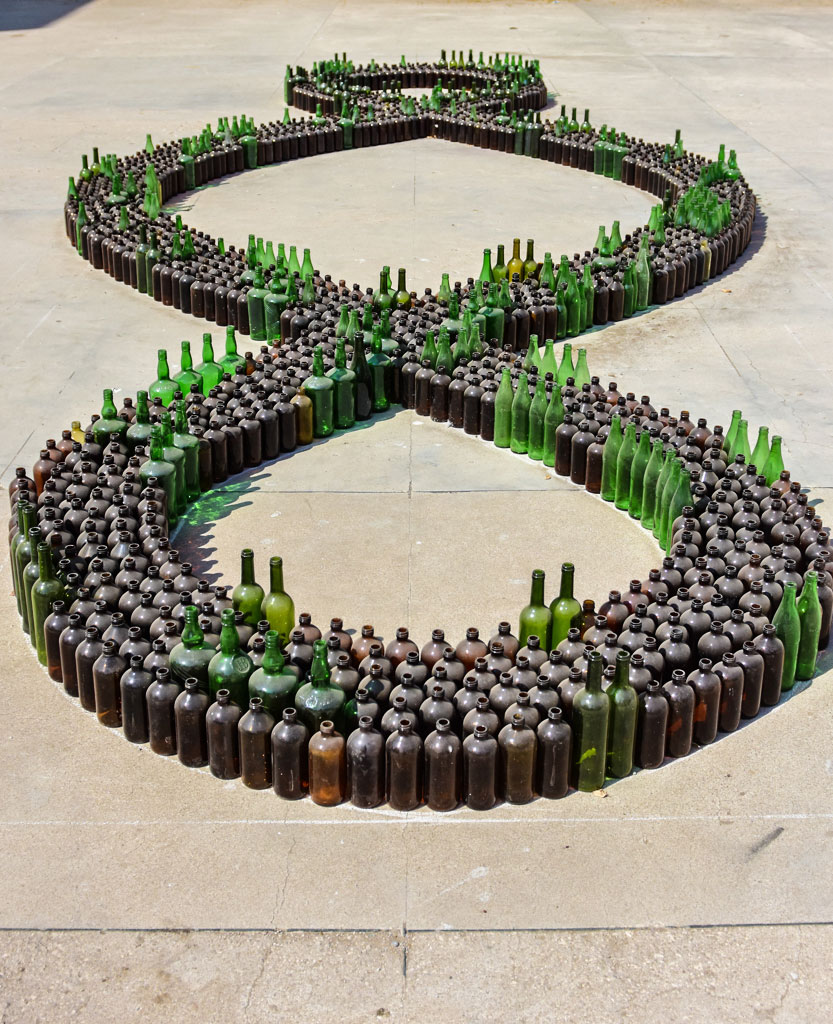
The Third Paradise, 2017.
Installation
Curated by Paolo De Grandis.
Mir Jabal
Born in 1987 in Quetta (Pakistan)
Lives and works in Quetta (Pakistan)
Mir Jabal received his BFA (Painting) from the University of Baluchistan and his MFA from the National College of Arts, Lahore. He currently teaches at the Institute of Art and Design, University of Baluchistan.
Mir Jabal writes of Lives Wasted Away for KB17: “I have been working on paintings based on the theme of our reductive materialist conception of organic life. Exhilarated despair, loss of selfness, moral masochism, sickness and disease are what I find to be its starkest and most relevant expressions. Visually, via the organic texture comprising dots, I have tried to create the microscopic feeling of the cellular structures of biology and human evolution. I have attempted to give expression to the reality of the human condition in its Darwinian, evolutionary sense. To say that our hopes and desires, our loves and hates are nothing other than the activity of flesh and bone, guided by the unhurried dictates of nature puts the individual in a very disturbing situation. The soul, mind and self become merely functions of the body, and nothing else remains; where mystery is to be had, there is mechanism. Indeed, I want to reflect in my paintings human nature in its truthful scientific and biological manifestation. My symbolism is an allusion to the innumerable aspects of our corporeal selves that guide our base nature.”

Lives Wasted Away, 2017.
Oil on canvas
152 x 95 cm.
Courtesy the artist
Miro Craemer
Born in 1969 in Weißenburg / Bayern (Germany)
Lives and works in Munich (Germany)
Miro Craemer is a fashion and social designer working as an independent designer for various labels in the field of sports fashion. In 2007, he created his own fashion and cultural label, “Miro Craemer”, and in 2011 he initiated the interdisciplinary symposium, “Wert @ Frei” at the Alte Literaturhaus. This interdisciplinary focus has manifested itself in his work, and since 2015, he has been conceiving and curating various projects which explore the interrelationship between art, fashion and textiles, staging performative works, hosting workshops and exhibiting in a variety of spaces including: the Kunstareal; the Kunstraum Milchstraße; the Neues Museum; the Pinakothek der Moderne; the Staatliches Industrie- und Textilmuseum; and at the Vienna Art Week, as well as creating a public textile installation, Cord of Desires (2016) in Karachi.
In his performative installation adapted for the Karachi Biennale 2017, OVERxCOME, Craemer explores the interrelationship between bodies, borders, surfaces, and materials, with constructive movement as the nucleus. The exegesis of the scenic-choreographic performance OVERxCOME lies in a week-long workshop with Miro Craemer, German dancer and choreographer Katrin Schafitel, Pakistani actor Sunil Shanker, and Cairo-based curator and writer Sara-Duana Meyer, in collaboration with German brass-player and Indologist Simon Otto and local actors, dancers, and musicians in Karachi. This process reflects Craemer’s interdisciplinary and participative approach in the creation of art, combining the fields of dance, theatre, music, textiles and fashion to form a collective exploration, transcription and transcendence of the liminal spaces of the self, the binary oppositions of man and woman, and cultural inhibitions. The textile concept of the work ostensibly delineates and codifies, requiring the audience to question first impressions, take up a position, and hence to become a decisive part of the performative installation. With this in mind, Craemer has developed costumes that utilise and subvert the semiotic implications of colour, material and shapes, causing the audience to second guess the meaning of these visual identifiers. The design finds a resonance with the South Asian tradition of kite-flying, in its oppositional interpretations of both freedom and attachment, and serenity and volatility, whilst the yellow and blue palette of the costumes inspired by Albrecht Altdorfer’s historical painting, Alexanderschlacht (1529), a depiction of a battle between the ‘oriental’ and ‘occidental’ in which the artist assigned colour schematically to differentiate between the opposing sides. Working these codes into the textile design, the textile aspect of OVERxCOME toys with notions of the oppositional and the complementary and asks the audience to reinterpret both historical and contemporary assumptions of distance and proximity, separation and connection.
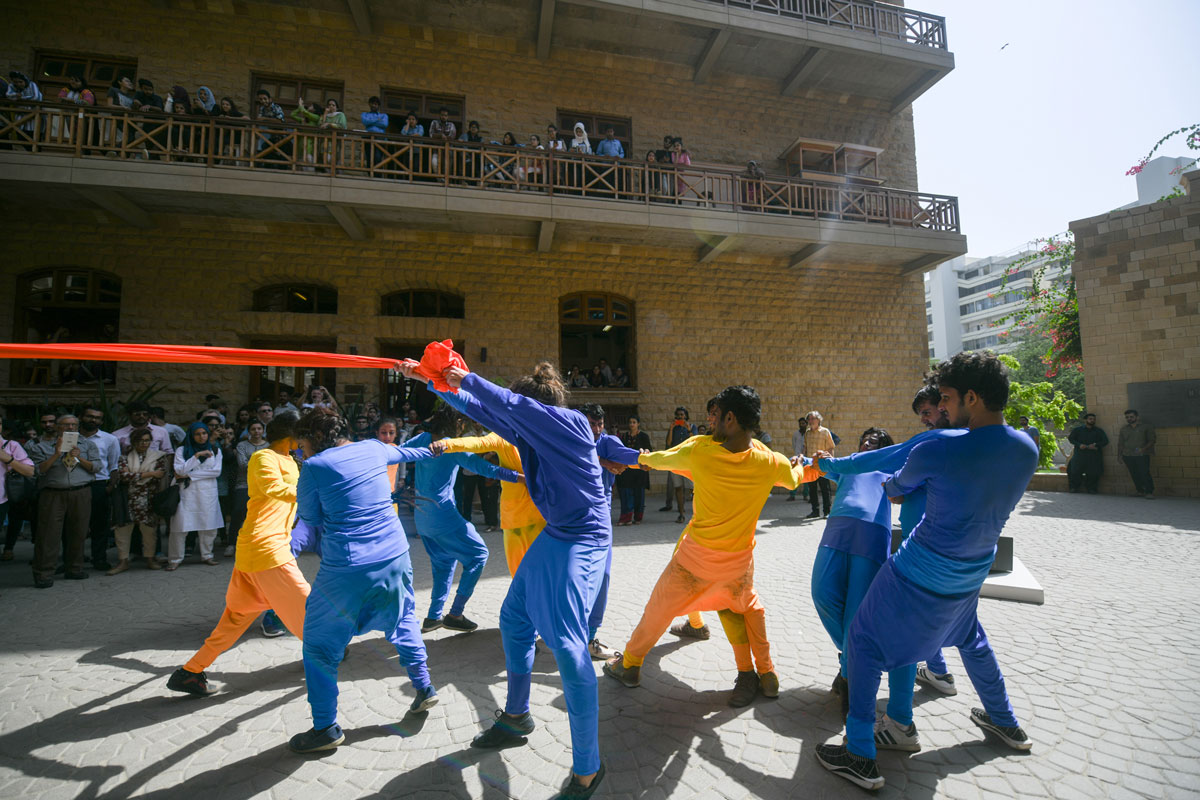
OVERxCOME, 2017.
Workshop and performative installation
25 min.
Mithu Sen
Born in 1971 in Burdwan (India)
Lives and works in New Delhi (India)
Mithu Sen completed her BFA (1995) and MFA (1997) from Kala Bhavan, Santiniketan, Visva Bharati, India and PG Programme from the Glasgow School of Art 2000-2001, UK. Her practice stems from a conceptual and interactive drawing background that has extended into video, sculpture, installation, poetry, sound and performance. Her journey critiques subtle hierarchical codes and hegemonies imposed on society, especially in those areas where humanity becomes a minority, whether sexual, political, regional, emotional or lingual. Swinging between distance and intimacy, Mithu makes the private public by engaging spectators into a game of active voyeurism. Her works not only open the barrier of intimacy to the public space but also highlight the increasing importance of interaction with the public as a part of the production of the artistic experience. Sen has participated and exhibited widely at museums, institutions, galleries and biennales, including Solomon R. Guggenheim Museum, New York; TATE Modern, London; Queens Museum, New York; Kiran Nadar Museum of Art, India; MOMAT and Tenshin Memorial Museum of Art, Japan; Peabody Essex Museum, USA; S.M.A.K Museum, Gent; and Palais de Tokyo, Paris; among others.
Shot on a beautiful morning following a storm in Bahia, Brazil, Icarus brings out tragedy in two-ways: first, in the tragic myth of Icarus, who died in a failed attempt to fly by gluing feathers to his arms, and, second, in the sorrowful death of the embryonic bird seen in the video. In this work on view at KB17, an army of ants gathers around a dead bird in an attempt to lift its lifeless body. In the process, the ants make the unformed wings move in a mock flap. As the horrific image merges with the beauty of nature’s life processes, it reveals the futility of dreams and the inevitability of death. In the context of these mythic allusions, the bird, a dreamer, becomes a martyr at the hands of fate and misfortune.

Still from Icarus, 2006-2007.
Video, 5:04 min.
Courtesy the artist
Moeen Faruqi
Born in 1958 in Karachi (Pakistan)
Lives and works in Karachi (Pakistan)
Moeen Faruqi is an artist and poet whose work aims to capture the everyday alienation of modernity. His paintings have been exhibited widely within Pakistan and internationally in Canada, Italy, Singapore, Bangladesh, the United Kingdom and India. His most recent solo exhibitions were at Canvas Gallery, Karachi, and at the Indus Valley School of Art and Architecture Gallery, Karachi. His poems have been published in various literary journals in Pakistan and abroad. His art practice is, at its basis, an existential investigation into the contemporary human experience of urbanity; his premise being that the relentless force of globalisation and international uniformity only lead to a greater sense of estrangement and separation. Primarily narrative in nature, his work finds its voice in figures who confront the viewer, almost as if they are pleading for relief from distorted relationships and artificial interactions. As such, the actors in his bizzarist theatre attempt to elicit a response of self-recognition from the audience. His technical practice reveals a profound fascination, almost a primitive enjoyment, in the creative process of painting a surface, manipulating and cajoling the flow of paint on a plane to explore new directions and avenues in his artwork.
Faruqi’s diptych for the Karachi Biennale 2017, Clifton Bridge, represents a stylistic transition from his narrative-based work to a concern with forms. It experiments with abstraction, with his figures becoming part of schematic colour fields, dispossessing them of their individuality, symbolising the destruction of selfhood in the contemporary metropolis. Commenting on the new artistic direction displayed in his work, Faruqi states: “It is almost as if the figures have become part of the background, or a part of the larger scheme of fragmented blocks of color. The idea is to fabricate and present a new imagery, but also to reduce characters in the painting to mere forms, not personalities.” Whilst aesthetically a move away from his previous work, Clifton Bridge conforms to the general theme of urban existentialism in his art practice, highlighting Faruqi’s perpetual experimentation with the medium of painting as a means to explore this thematic.
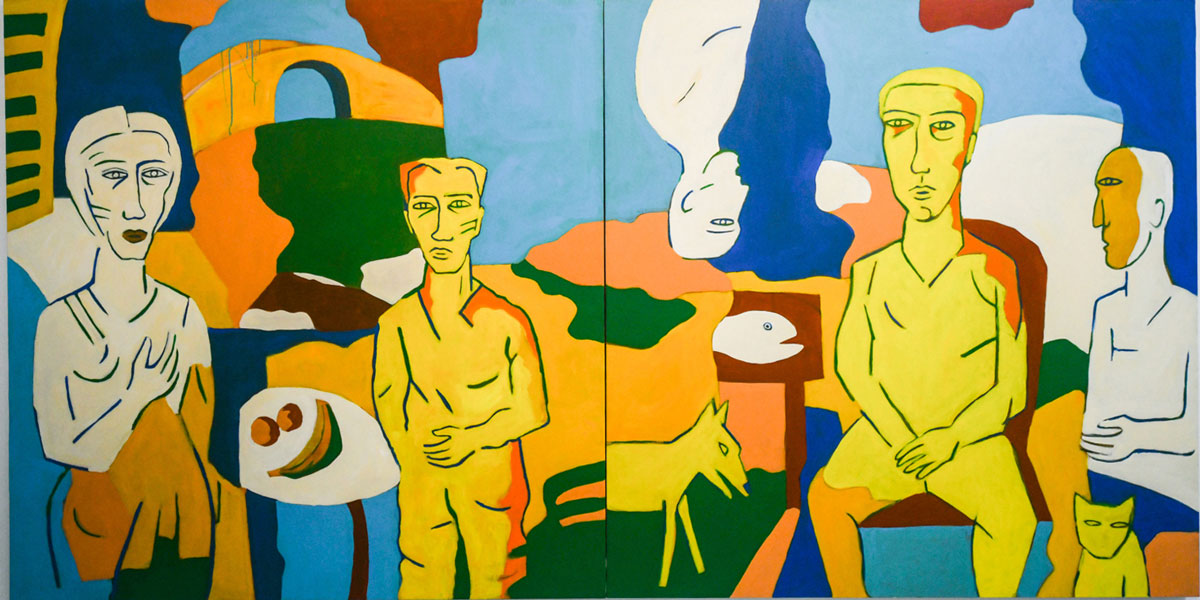
Clifton Bridge Is Falling Down, 2017.
Acrylic on canvas
152 x 305 cm.
Courtesy the artist
Mohsin Shafi
Born in 1982 in Sahiwal (Pakistan)
Lives and works in Lahore (Pakistan)
Mohsin Shafi received both his Master’s and BFA degrees from the National College of Arts (NCA), Lahore. He is currently a visiting faculty member in the MA Visual Arts Department at the NCA, Lahore. Shafi has showcased his work at prominent galleries in Pakistan as well as in international exhibitions. He was part of the Vasl Artists residency in 2010 in Karachi and was an Artist in Residence at the Rondo Studios in Graz, Austria in 2012. As well as being included in significant collections in Pakistan, his work is in the permanent collection of The Museum of Sacred Art (MOSA) in Belgium and recently been acquired for the permanent collection of the Department of Book Art at Mills College, San Francisco. His images have also been used as covers for books by Agnar Artúvertin, Martin Walser and Gabriel Rosenstock, as well as other writers and poets. Mohsin is an active member of the Awami Art Collective, which is a unique group of artists and activists intervening in the public space in Pakistan for the cause of peaceful coexistence and the celebration of diversity.
Mohsin Shafi writes of his submission for KB17: “The visuals in the installation intend to articulate the notions of safety within physical and intellectual spaces of representation: the safety of being visible for having non-conforming ideas within a militant-state and of being proclaimed the Other by the spectator’s eye. This is the danger of being seen through the lens of sexual taboos, gender binaries, ethnic hierarchies, religious freedoms and the public availability of that information. These are the struggles of being looked at and judged, of being reduced to a cliché or a cultural smear. Questioning how to bear witness to the complexities of the present times, the installation responds to the aesthetic and ambiguities of our society.”

This is Not the Way Home, 2017.
Mixed media installation
305 x 549 cm.
Courtesy the artist
Momin Zafar
Born in 1981 in Karachi (Pakistan)
Lives and works in Karachi (Pakistan)
Momin Zafar's professional experience is in photography, design, theatre, writing and visual art. He received a Bachelors degree in Communication Design from Indus Valley School of Art and Architecture, Karachi (2003), then worked extensively with students at undergraduate, primary and secondary school levels. Having performed in several plays, and recitals with a vocal ensemble, he is currently a multidisciplinary freelancer and teaches part-time.
Momin Zafar writes of his performance for KB17: “Halt and Flow is an interactive piece played out akin to yoga on a Twister mat, with a grid of textured circles forming a colour-coded map of Karachi. With allusions to physical threat, personal agency, traffic density and unconventional spirituality, it is about the specificity of locating oneself in space; how location and interaction may distort personal rhythms; and how the affectee perseveres to maintain intention and motion.”
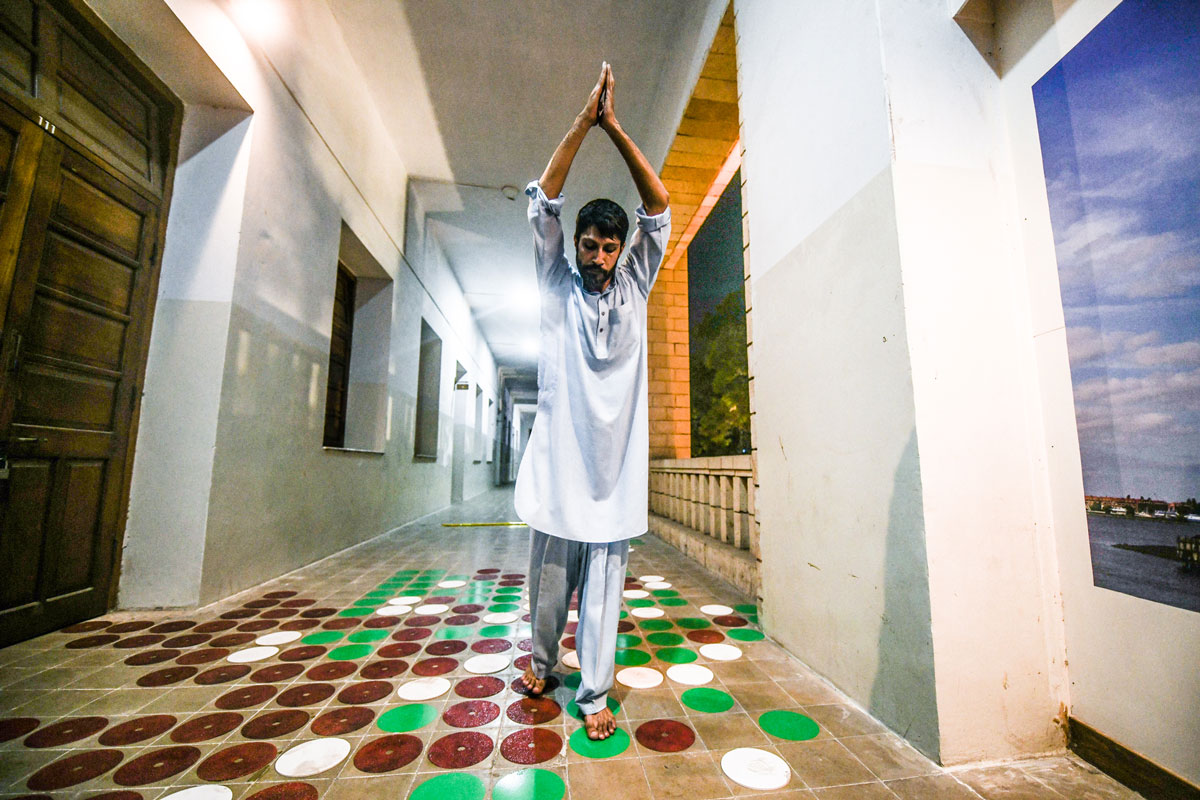
Halt and Flow, 2017.
Interactive performance on reflective vinyl, sandpaper and carpet
60 min.













